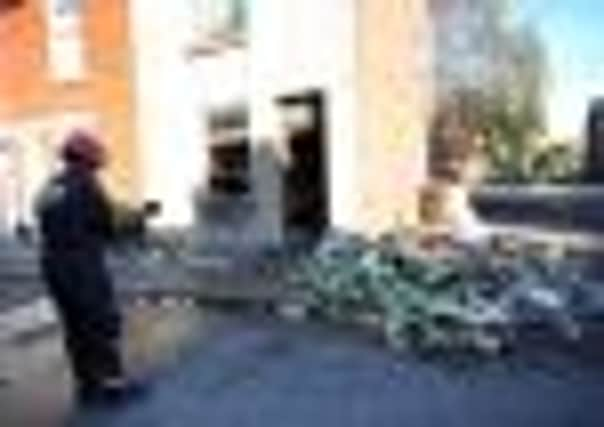Hoarder spends the night buried beneath his junk as ceiling gives way


Stephen Tatham, 53, spent Tuesday night buried under rubble after the dramatic incident in Agbrigg, Wakefield.
Neighbours had heard a banging noise from Mr Tatham’s end terrace house on Newland Street on Tuesday night.
Advertisement
Hide AdAdvertisement
Hide AdBut it was not until yesterday morning – when a resident heard a cry for help from inside the dilapidated stone-clad house – that police were alerted.
Police contacted the fire service and paramedics and the Yorkshire Air Ambulance was sent to the scene.
Firefighters arrived just after 8am and had to clear piles of hoarded rubbish – along with rubble, furniture, joists and floorbaords – to get to the stricken man.
Mr Tatham, who is an administrative worker for Wakefield Council, was taken by ambulance to Pinderfields Hospital at Wakefield just after 9.30am suffering from suspected hypothermia.
Advertisement
Hide AdAdvertisement
Hide AdNeighbours said Mr Tatham has lived in the house for more than 20 years, is smartly dressed and keeps himself to himself.
Residents said the curtains were kept drawn and they had no idea the house was so full of accumulated junk.
Chris Kirkby, a West Yorkshire Fire Service station manager, was incident commander as around 25 firefighters dealt with yesterday’s emergency call.
He said: “The gentleman is a hoarder. Because of the weight of the materials he had got stored in the property he has ended up falling from the first floor.
Advertisement
Hide AdAdvertisement
Hide Ad“We had to slowly remove all the rubble surrounding the casualty. He was trapped under some quite heavy timbers.
“We have safely removed the casualty. The main thing he was suffering from was cold, hypothermia.
“He was talking to us throughout the rescue. We don’t believe he has got crush injuries at this stage.
“He has come down with the collapse. It’s not like things have dropped on top of him.”
Advertisement
Hide AdAdvertisement
Hide AdHe added: “The joists will have become weakened and eventually they will have just given way.”
Street cleaning teams from Wakefield Council were yesterday removing the piles of magazines, CDs, plastic and glass bottles, which had been cleared out of the property.
Mr Tatham’s next door neighbour, who didn’t want to be named, said: “About 10 years ago I could say hello to him, but in recent years he has become more withdrawn.”
Noreen Hussain, 26, has lived opposite the house for five years. She said his wheelie bins had never been put out for collection.
Advertisement
Hide AdAdvertisement
Hide AdShe added: “He is such a nice guy. He is always dressed smart with creases in his trousers and goes to work every day in a shirt and tie.”
John Marshall and his wife Margaret, both 67, have lived on Newland Street for 45 years.
Mrs Marshall said: “Every morning he would go to his work in a collar and tie.”
Mr Marhall said: “He is a nice enough fella. He would come out of the house every day immaculately dressed.
“We didn’t realise the house was in such a state.
“Nobody has ever been inside his house.”
Advertisement
Hide AdAdvertisement
Hide AdDave Exley, 59, of nearby Newlands Court, said: “The cobwebs in the front window were enormous, it looked like the Triffids were coming.”
A Wakefield Council spokeswoman confirmed Mr Tatham is employed by the local authority, but was not prepared say which department he works for. The spokeswoman added: “The building has been inspected and it does not appear to be structurally dangerous.”
A Yorkshire Ambulance Service spokeswoman said: “We sent an ambulance and our hazardous area response team. The Yorkshire Air Ambulance was despatched but wasn’t needed as the patient was transported to hospital by ambulance.”
Paul Nicholson, a senior lecturer in psychological therapies and mental health at Leeds Metropolitan University, said hoarding is a form of obsessional compulsive disorder.
Advertisement
Hide AdAdvertisement
Hide AdHe added: “There’s prevention of harm hoarding, where people think something bad is going to happen if they throw things away. Or they might think they are going to bring harm to someone else by throwing things away, such as bottles.
“There is also deprivation hoarding, where people think they can’t get rid of an item because they might need it later in life.”